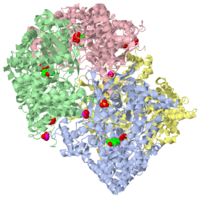User:Max Lein/Sandbox
From Proteopedia
| |||||||||
| 1gpa, resolution 2.90Å () | |||||||||
|---|---|---|---|---|---|---|---|---|---|
| Ligands: | , | ||||||||
| Non-Standard Residues: | |||||||||
| Activity: | Phosphorylase, with EC number 2.4.1.1 | ||||||||
| |||||||||
| |||||||||
| Resources: | FirstGlance, OCA, PDBsum, RCSB | ||||||||
| Coordinates: | save as pdb, mmCIF, xml | ||||||||
Contents |
STRUCTURAL MECHANISM FOR GLYCOGEN PHOSPHORYLASE CONTROL BY PHOSPHORYLATION AND AMP
About this Structure
Reaction
Glycogen phosphorylase catalyzes the degradation of glycogen into glucose-1'-phosphate.
History
Glycogen phosphorylase was the first phosphorylase enzyme to be discovered, and the first example of regulation via covalent modification.
In the 1930s, the first work done by Carl and Gerty Cori. They proved that the enzyme exists in 'A' and 'B' forms, and they showed that the reverse reaction produced glycogen. They won the Nobel Prize in 1947 along with Bernardo Housay of Argentina for their work on carbohydrate metabolism. This was also the first example of a polymerizing enzyme, inspiring others to look for other polymerizing enzymes.
Subsequently, Earl Sutherland found that the 'B' form predominates in resting muscle and epinephrine triggers activation to form 'A'. Since then, many groups have worked on this enzyme, both to understand its mechanism and to discover drug targets. Crystal structures have been obtained for the protein in the 'A' and 'B' form, in the presence of natural substrates, inhibitors, and transition state analogs. Please see the end of this article for links to crystallographic information.
Facts about GP
Protein comes from rabbit muscle tissue, where energy from glucose is needed. There is an isozyme from liver tissue that is regulated by glucagon instead of epinephrine, with a different gene that encodes it and different regulation properties. Activity and Regulation of GP 1. GP catalyzes the clipping of a glucose molecule off of the reducing end of glycogen. It employs a cofactor called pyridoxal-5’ –phosphate, that is located in the active site and bound to a lysine residue with a Schiff base linkage. PLP shuttles the phosphate group onto the substrate. 2. There are two forms, A and B, and two states, T and R, for the enzyme. B = nearly inactive dimer, stabilized by electrostatics at N-terminus (w/basic residues) interacting with pocket of acidic residues. Phosphorylase kinase catalyzes addition of phosphate to Ser14, tightens structure of N-terminal portion of each chain, resulting in conformation change to form A. Phosphorylation causes electrostatic interference between phosphate group and acidic residues, forcing the N-terminal domain out of the acidic environment and into a region with several arginine side chains. Phosphatase removes phosphate, returns GP to form B. Response to hormone epinephrine (in muscle), (fight-or-flight response) or glucagon (in liver), increases available energy to organism as a whole. - In b form, enzyme can be activated: Activated by AMP, (cell doesn’t get signal, but needs energy for itself). Inactivated by ATP, glucose (cell already has enough energy for itself, phosphorylation will not activate) - Having two overlaid levels of control allows the appropriate response in either situation. - Phosphoglucomutase shifts carbon chain over 1.
1GPA is a Single protein structure of sequence from Oryctolagus cuniculus. Additional information on 1GPA is available in a page on Glycogen Phosphorylase at the RCSB PDB Molecule of the Month. Full crystallographic information is available from OCA.
Reference
Structural mechanism for glycogen phosphorylase control by phosphorylation and AMP., Barford D, Hu SH, Johnson LN, J Mol Biol. 1991 Mar 5;218(1):233-60. PMID:1900534
Page seeded by OCA on Wed Jul 23 10:43:26 2008


